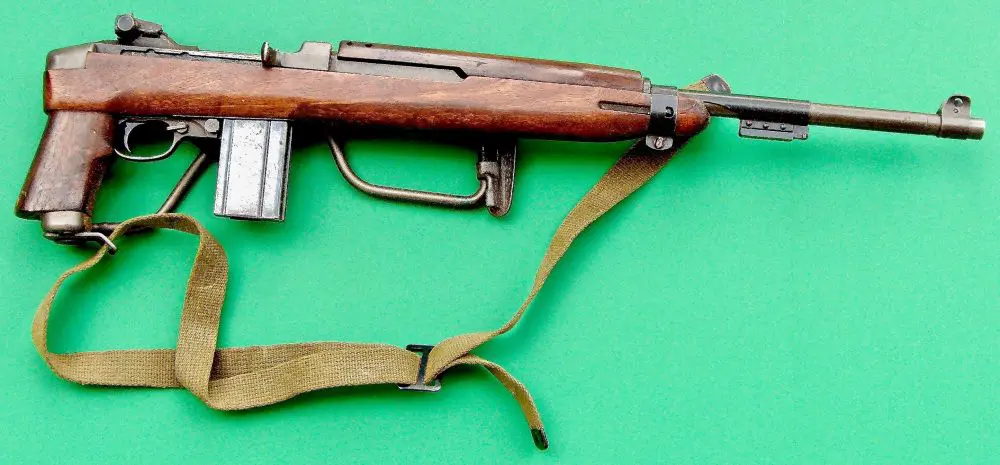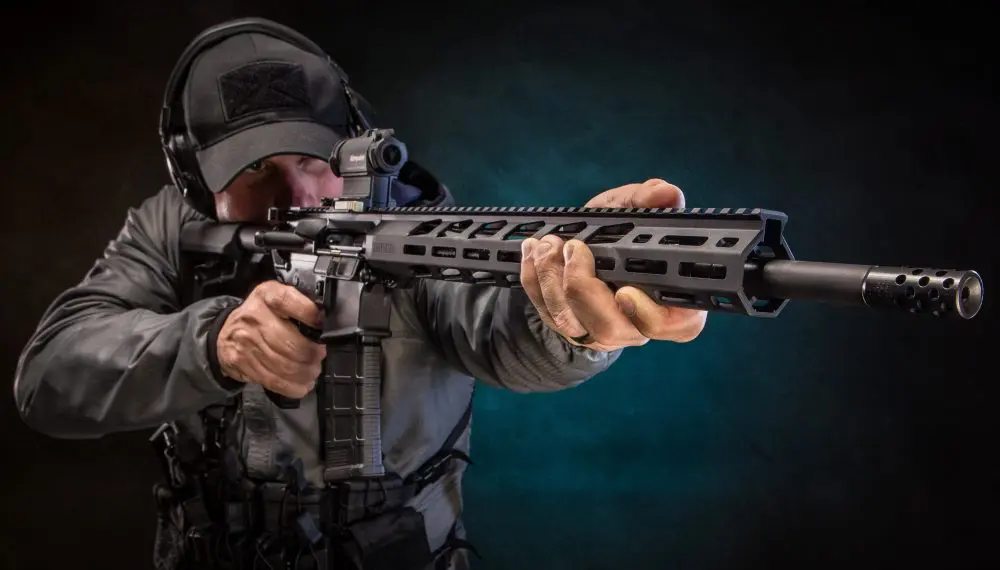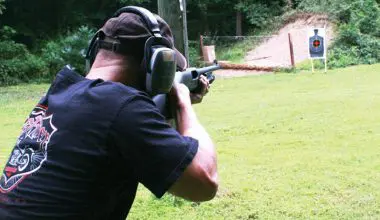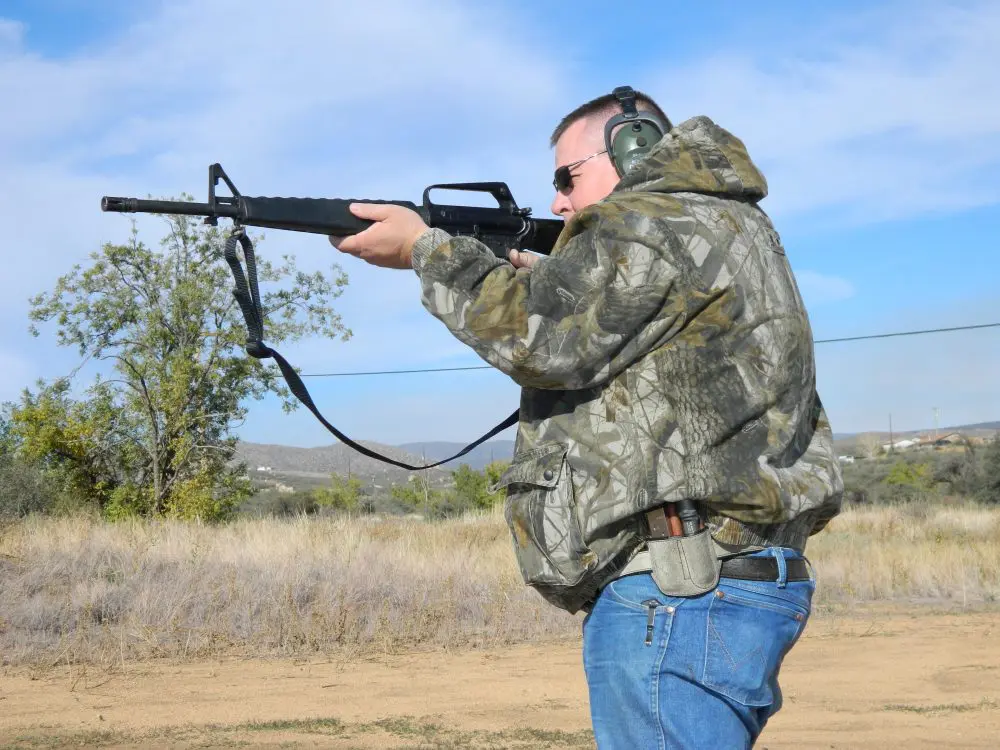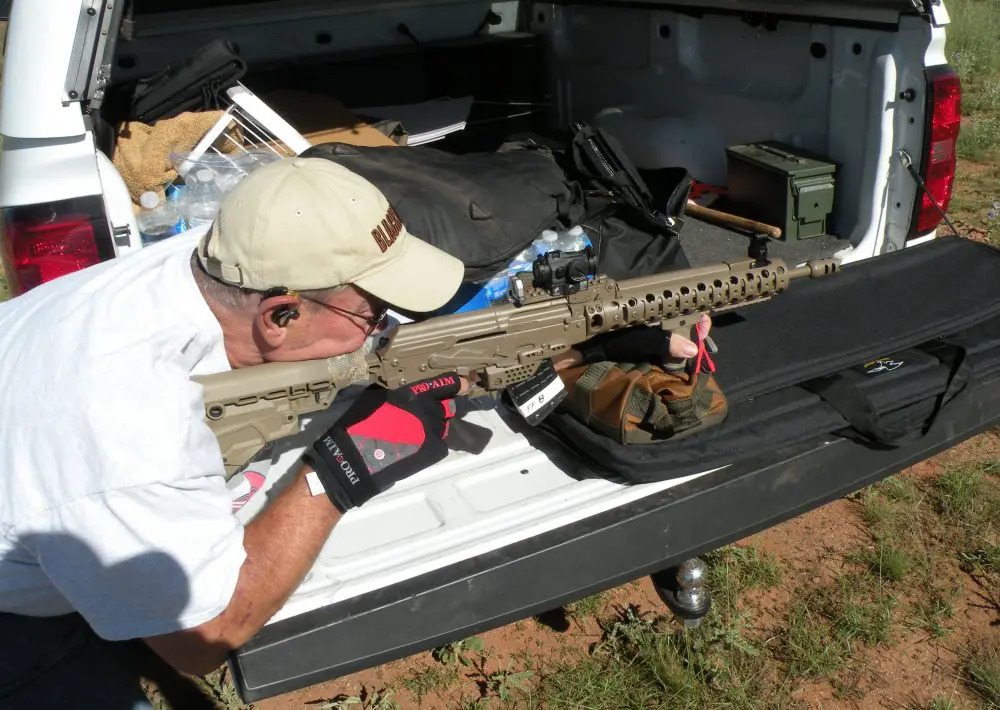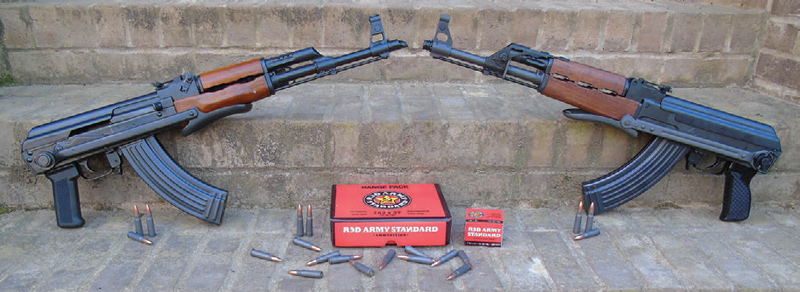
World War II saw the world’s militaries equipped on a truly breathtaking scale. Industrial art gave way to military necessity, and the same technology that mass-produced everything from cargo planes and coffeemakers to cigarette lighters and children’s toys found its place in gunmaking.
As a result, WWII brought the advent of guns like the German MP40, American M3 Grease Gun, and British Sten, each of which made extensive use of industrial steel pressings for many of their vital components. Sheet steel pressings stamped out quickly produced guns on a scale previously unimagined.
The German stamped-receiver StG44 typified the apex of the art during the war. Despite German industry being bombed day and night, the Germans were still able to produce hundreds of thousands of these revolutionary rifles right up until the closing days of the war.
A young Soviet tank sergeant named Mikhail Timofeyovich Kalashnikov took inspiration from these guns and whipped up a fairly remarkable firearm himself. Perhaps you’ve heard of it.
Table of Contents
GENERATIONS
The very first AK-47 rifles were actually built on stamped receivers. These rare early guns were found to be insufficiently robust and the weapon was subsequently redesigned around a forged receiver cut from a big chunk of steel.
Given the penchant of Cold War Communists for secrecy, the details of this transition are still not fully understood. In this case, a heavy solid steel blank is run through a mill or series of mills until everything that is not an AK-47 receiver is cut away. The resulting part is robust and durable, but by definition slow and tedious to manufacture.
In the mid-1950s, the Soviets redesigned the AK-47 around an improved and reinforced version of their original stamped receiver. These receivers were pressed out quickly on large industrial steel presses and reinforced with a series of heavy rivets. Manufacturing time was a fraction of that of the earlier guns, and these stamped-frame weapons will likely remain in active service somewhere in the world when my great-grandchildren are grappling with the thorny problem of international terrorism.
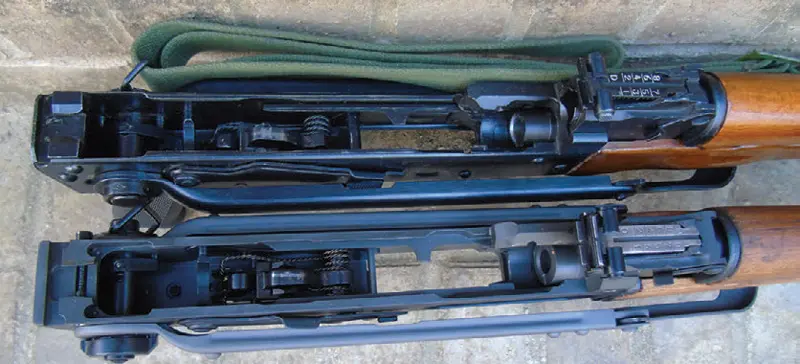
GENESIS
Milling machines nowadays are sophisticated computer-controlled affairs wherein a design is birthed in digital space and translated into steel by the combination of an appropriate computer program and a skilled machinist.
Mechanisms can be designed and tested in the digital realm to ensure that parts interact as intended and tolerances are right before the first piece of steel is cut. Modern Computer Numerically Controlled (CNC) machines incorporate a rotating tool head that allows them to perform multiple functions without stopping for retooling. When wielded by a skilled operator, these devices can make most anything imaginable out of steel or aluminum.
Industrial steel presses incorporate an expensive die that forms its shape into sheet steel when pressed together under enormous pressure. These presses often incorporate a heavy flywheel to store energy used for the pressing process. Dies can be designed to form multiple copies of an object with each pass or can be of the progressive sort that forms a finished part via a series of sequential pressing operations.
While the initial startup cost for these machines is high, once the presses and dies are properly configured, they can be operated by relatively unskilled operators and run at surprisingly high speeds. As a result, guns made via this process can be built in large quantities for a fraction of the cost of milled weapons and at a much faster rate.
For example, the United States produced nearly 1.5 million Thompson submachine guns during WWII. These guns were built around heavy, complex machined receivers cut from big blocks of forged steel and cost about $45 each to build.
By contrast, M3 Grease Guns and British Sten guns were built predominantly from steel pressings and cost $18 and $9 each respectively. While that may seem ridiculously cheap, adjusted for inflation that would make a Thompson roughly $585, the Grease Gun $234, and the Sten $117 today.
Another nifty tool in common use for industrial manufacturing today is the EDM wire machine. EDM stands for Electrical Discharge Machining. This computer-controlled device uses a tiny (not much larger than a human hair) strand of brass wire that is charged with electricity. When run continuously from a big spool and controlled by a set of incredibly precise actuators, this wire zips through a piece of metal like a razor through paper.
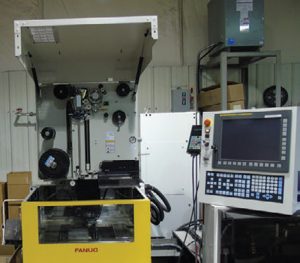
In a computer-controlled EDM machine, this process cuts the most intricate geometry from even the thickest pieces of steel or aluminum. This is how the magazine well was probably cut in your AR-15 lower receiver.
Our world is awash in industrial pressedsteel components. The hood of your car, the body of your washing machine, the outside of your microwave, the door to your refrigerator, and the eyelets in your sneakers are all made from pressed sheet metal.
OUR CONTESTANTS
Our forged-receiver AK is an underfolder called the AT47 built from a refinished Yugoslavian parts kit on a U.S.-made receiver by American Tactical Imports. The threaded muzzle on my copy is capped by a flat muzzle nut, just like the originals, and the forearm includes a nifty flipup grenade launching sight should you feel the need to address the
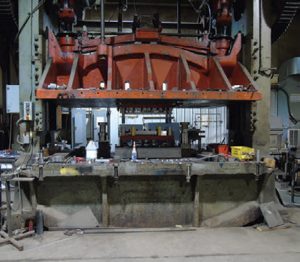
neighbor’s incessantly barking dog with a fusillade of rifle grenades. There’s also an unusual flip-up night sight built into the front sight base. It’s not found on most AK rifles. Sadly, the night sight no longer glows.
Our stamped receiver rifle is an original Chinese Norinco Type 56 bought new at a gun show in 1985 for $325. This rifle included three magazines and a bayonet and features the same underfolding stock as the ATI gun. As is the case with most Chinese firearms, the lustrous blued finish is gorgeous and the workmanship superb.
The AT47 forged receiver gun is nearly two pounds heavier than the Chicom stamped-receiver counterpart. As a result, it does feel more robust in the hand.
The magazine well on the AT47 is a little bit larger than that on the stamped version, so the magazines have just the tiniest wobble. But acceptable tolerances on AK rifles are notoriously broad and, while a bit annoying, this actually allows for easier and faster magazine changes.
Both guns run exactly the same way. Push the button to open or close the stock struts and pivot the buttplate as needed. The magazine release operates with the thumb of the weak hand, and magazines must be tilted in and out of place.
The charging handle protrudes on the right and reciprocates with the bolt carrier. It can be manipulated by reaching over with the left hand, but it is frequently faster just to suck it up and take your hand off the pistol grip. Untold legions of terrorists do it this way—and quite effectively, I might add.
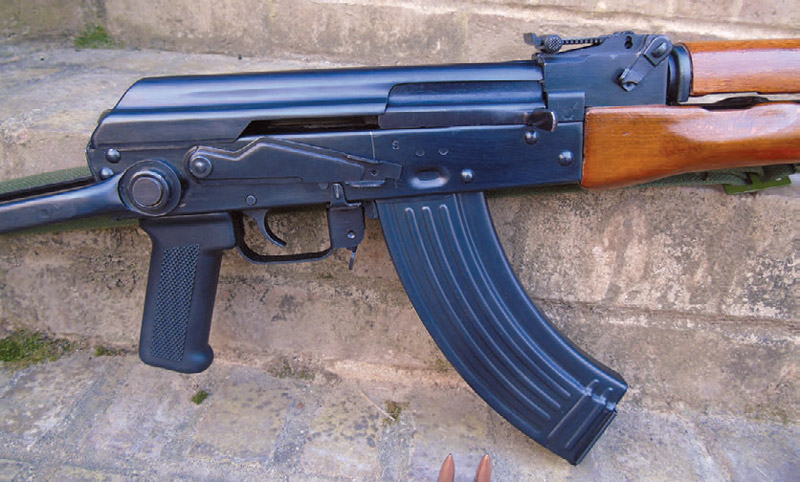
That wretched ranch gate safety is safe when up and off when down. In military guns, the middle position is full-auto. Curse it though we will for its clunky inconvenience and noisy operation, it is undeniably effective. The sights are yesterday’s news and not the world’s most efficient, but they are easy to use. Even a child could master them, and many have. Adjusting the sights requires a dedicated tool.
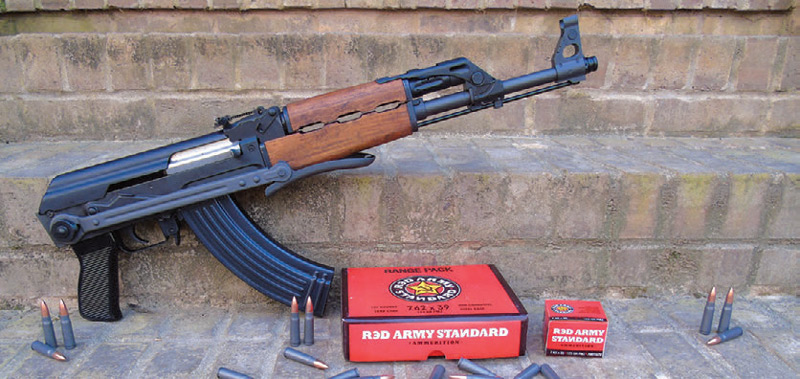
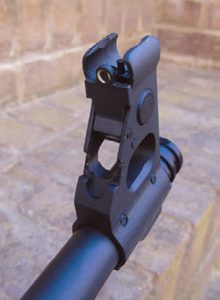
The Chicom AK sports a chrome-lined bore and chamber, as do most Kalashnikov products (though the AT47 does not). Both rifles accept the standard Combloc bayonet as well as RPK drum magazines, should your proclivities extend to such. Slings mount on the left side as is appropriate, and stripping procedures are identical with one exception.
The AT47 has an ancillary catch that provides a bit of extra security for the top cover. But it almost takes a third hand to get the cover off given the extra switch, and the gun will run just fine without the cover in place. Both forearms heat up quickly after heavy use but, in all fairness, so does that of your Information-Age SCAR.
The 7.62x39mm M43 round remains one of the best military rifle cartridges ever designed. Its tapered walls necessitate a sharply curved magazine but facilitate reliable extraction when dirty or fouled. The round is effective out to common rifle engagement ranges and with expanding bullets will reliably drop a white-tail deer.
On the range the two rifles were essentially interchangeable. Accuracy on both guns was comparable at all ranges. I did have a slight problem out of the box with the AT47, but it was easily remedied. The bolt carrier jumped out of its mounting slot just a bit at full recoil and stuck to the rear with each shot. I ordered a polymer buffer from Amazon for $7 and it fixed the problem. Thusly configured, both guns ran without a hiccup.

I have a full-auto RPK that I have run several thousand rounds through without cleaning, and it just won’t quit. Kalashnikov rifles enjoy their reputation for reliability and easy maintenance for a reason.
I tried to divine some substantive difference between these two guns that might make one better than the other. At the end of the day, as I stood staring at two hot guns and a pile of empty steel cartridge cases, I really didn’t have a preference.
Taking weight into account, both rifles were otherwise very similar when it came to function and reliability once the trivial buffer issue was addressed.
BIG PICTURE
Building a gun out of a big block of forged steel requires time and a certain mastery of the art of machining. Even with modern computercontrolled machines, this process is tedious. But the resulting weapon is undeniably robust and more expensive than its stamped counterpart.
Stamped receiver guns are quicker and cheaper to build and do admittedly lose some cool points as a result. But given the modern state of the art, stamped receivers are just about as indestructible as their machined counterparts. Our great-grandchildren will not wear these guns out.
So which type is best? That is a question that might best be left to the philosophers.
Chinese military arms were prohibited from importation via executive fiat decades ago, but stamped AK folders from other places are still plentiful and not too spendy.
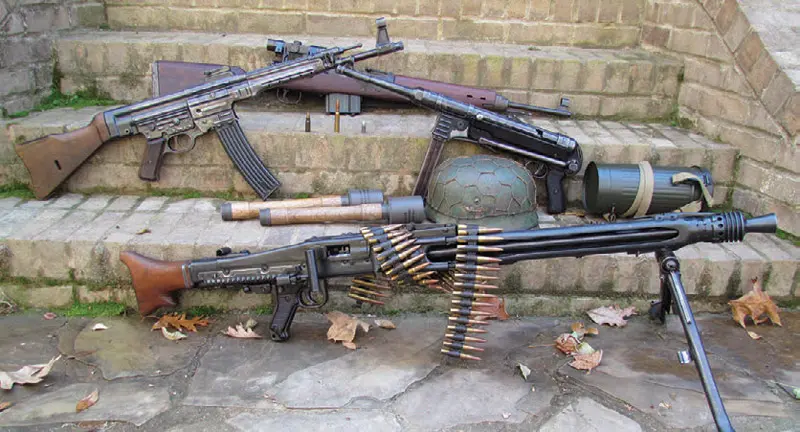
However, if you occasionally yearn for the old days and want a connection to times when the world was not so awash in electronics, plastic, and disposable everything, a classic forged receiver AK like the AT47 from ATI is beautifully executed and a great way to get there.
